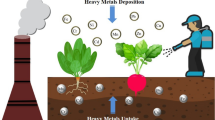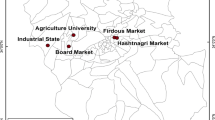Abstract
Information about heavy metal concentrations in food products and their dietary intake are essential for assessing the health risk of local inhabitants. The main purposes of the present study were (1) to investigate the concentrations of Zn, Cu, Pb, and Cd in several vegetables and fruits cultivated in Baia Mare mining area (Romania); (2) to assess the human health risk associated with the ingestion of contaminated vegetables and fruits by calculating the daily intake rate (DIR) and the target hazard quotient (THQ); and (3) to establish some recommendations on human diet in order to assure an improvement in food safety. The concentration order of heavy metals in the analyzed vegetable and fruit samples was Zn > Cu > Pb > Cd. The results showed the heavy metals are more likely to accumulate in vegetables (10.8–630.6 mg/kg dw for Zn, 1.4–196.6 mg/kg dw for Cu, 0.2–155.7 mg/kg dw for Pb, and 0.03–6.61 mg/kg dw for Cd) than in fruits (4.9–55.9 mg/kg dw for Zn, 1.9–24.7 mg/kg dw for Cu, 0.04–8.82 mg/kg dw for Pb, and 0.01–0.81 mg/kg dw for Cd). Parsley, kohlrabi, and lettuce proved to be high heavy metal accumulators. By calculating DIR and THQ, the data indicated that consumption of parsley, kohlrabi, and lettuce from the area on a regular basis may pose high potential health risks to local inhabitants, especially in the area located close to non-ferrous metallurgical plants (Romplumb SA and Cuprom SA) and close to Tăuții de Sus tailings ponds. The DIR for Zn (85.3–231.6 μg/day kg body weight) and Cu (25.0–44.6 μg/day kg body weight) were higher in rural areas, while for Pb (0.6–3.1 μg/day kg body weight) and Cd (0.22–0.82 μg/day kg body weight), the DIR were higher in urban areas, close to the non-ferrous metallurgical plants SC Romplumb SA and SC Cuprom SA. The THQ for Zn, Cu, Pb, and Cd was higher than 5 for <1, <1, 12, and 6 % of samples which indicates that those consumers may experience major health risks.




Similar content being viewed by others
References
Ali MHH, Al-Qahtani KM (2012) Assessment of some heavy metals in vegetables, cereals and fruits in Saudi Arabian markets. Egypt J Aquat Res 38:31–37
ATSDR (2004) Toxicological profile for copper. US Department of Health and Human Services. http://www.atsdr.cdc.gov/toxprofiles/TP.asp?id=206&tid=37. Accessed 12 April 2012
ATSDR (2005) Toxicological profile for zinc. US Department of Health and Human Services. http://www.atsdr.cdc.gov/substances/toxsubstance.asp?toxid=54. Accessed 12 April 2012
ATSDR (2011) Priority list of hazardous substances. US Department of Health and Human Services. http://www.atsdr.cdc.gov/SPL/index.html. Accessed 10 April 2012
Bi XY, Feng XB, Yang YG, Li XD, Shin GPY, Li FL, Qiu GL, Li GH, Liu TZ, Fu ZY (2009) Allocation and source attribution of lead and cadmium in maize (Zea mays L.) impacted by smelting emissions. Environ Pollut 157:834–839
Big CL, Lăcătuşu R, Damian F (2012) Heavy metals in soil-plant system around Baia Mare city, Romania. Carpathian J Earth Environ Sci 7(3):219–230
Bordean DM, Gergen I, Gogoasa I, Oprea G, Pirvulescu L (2011) Mathematical model evaluation of heavy metal contamination in vegetables and fruits. J Food Agric Environ 9:680–683
Cherfi A, Abdoun S, Gaci O (2014) Food survey: levels and potential health risks of chromium, lead, zinc and copper content in fruits and vegetables consumed in Algeria. Food Chem Toxicol 70:48–53
Chien LC, Hung TC, Choang KY, Yeh CY, Meng PJ, Shieh MJ, Han BC (2002) Daily intake of TBT, Cu, Zn, Cd and As for fishermen in Taiwan. Sci Total Environ 285:177–185
Chunling L, Chuanping L, Yan W, Xiang L, Fangbai L, Gan Z, Xiangdong L (2011) Heavy metal contamination in soils and vegetables near an e-waste processing site, south China. J Hazard Mater 186:481–490
Damian G, Damian F, Năsui D, Pop C, Pricop C (2010) The soils quality from the southern – eastern part of Baia Mare zone affected by metallurgical industry. Carpathian J Earth Environ Sci 5(1):139–147
Dong J, Mao WH, Zhang GP, Wu FB, Cai Y (2007) Root excretion and plant tolerance to cadmium toxicity—a review. Plant Soil Environ 53(5):193–200
EC (2006) Commission Regulation (EC) No 1881/2006, setting maximum levels for certain contaminants in foodstuffs. Off J Eur Communities L364:5
EC (2008) Commission Regulation (EC) No 629/2008, amending Regulation (EC) No 1881/2006 setting maximum levels for certain contaminants in foodstuffs setting maximum levels for certain contaminants in foodstuffs. Off J Eur Communities L173:6
FAO (2004) Recommended intake for individuals, dietary reference intakes [DRIs]. National Academy of Sciences, Washington
FAO-WHO (2001) Food additives and contaminants. Codex Alimentarius Commission. Joint FAO/WHO Food Standards Program, ALI-NORM01/12A, 1–289
FAO-WHO (2007) Contaminants. Codex Alimentarius, vol. XVII, 1st edn. FAO/WHO, Codex Alimentarius Commission, Rome
FAO-WHO (2011) Food additives and contaminants. Codex Alimentarius Commission. Joint FAO/WHO Food Standards Program, CF/5 INF/1, 1–90
Ferrante M, Fiore M, Ledda C, Cicciù F, Alonzo E, Fallico R, Platania F, Di Mauro R, Valenti L, Sciacca S (2013) Monitoring of heavy metals and trace elements in the air, fruits and vegetables and soil in the province of Catania (Italy). Ig Sanita Pubbl 69(1):47–54
Hărmănescu M, Alda L, Bordean D, Gogoaşă I, Gergen I (2011) Heavy metals health risk assessment for population via consumption of vegetables grown in old mining area; a case study: Banat County, Romania. Chem Cent J 5:64–74
Jarup L (2003) Hazards of heavy metal contamination. Br Med Bull 68:167–182
Lăcătuşu R, Lăcătuşu AR (2008) Vegetable and fruits quality within heavy metals polluted areas in Romania. Carpathian J Earth Environ Sci 3(2):115–129
Lăcătuşu R, Răuţă C, Cârstea S, Ghelase I (1996) Soil-plant-man relationships in heavy metal polluted areas in Romania. Appl Geochem 11:105–107
Li Z, Ma Z, Kuijp TJ, Yuan Z, Huang L (2014) A review of soil heavy metal pollution from mines in China: pollution and health risk assessment. Sci Total Environ 468–469:843–853
Luo CL, Liu CP, Wang Y, Liu X, Li FB, Zhang C, Li XD (2011) Heavy metal contamination in soils and vegetables near an e-waste processing site, south China. J Hazard Mater 186(1):481–490
Michaud AM, Chappellaz C, Hinsinger P (2008) Copper phytotoxicity affects root elongation and iron nutrition in durum wheat (Triticum turgidum durum L.). Plant Soil 310:151–165
Mihali C, Oprea G, Michena A, Jelea SG, Jelea M, Man C, Şenilă M, Grigore L (2013) Assessment of heavy metals content and pollution level in soil and plants in Baia Mare Area, NW Romania. Carpathian J Earth Environ Sci 8(2):143–152
NIS Romania (2013) Life expectancy, October 2013. http://www.insse.ro/cms/files/publicatii/pliante%20statistice/07-Speranta%20de%20viata_n.pdf. Accessed Apr 2015
Pauline L, Saumel I (2014) Orchards for edible cities: cadmium and lead content in nuts, berries, pome and stone fruits harvested within the inner city neighbourhoods in Berlin, Germany. Ecotoxicol Environ Saf 101:233–239
Trichopoulos D (1997) Epidemiology of cancer. In: De Vita VT (ed) Cancer, principles and practice of oncology. Lippincott Company, Philadelphia, pp 231–258
Turkdogan MK, Kilicel F, Kara K, Tuncer I (2002) Heavy metals in soil, vegetables and fruits in the endemic upper gastrointestinal cancer region of Turkey. Environ Toxicol Pharmacol 13:175–179
US EPA (1989) Guidance manual for assessing human health risks from chemically contaminated, fish and shellfish EPA-503/8-89-002. US Environmental
US EPA (2000a) Risk-based concentration table. Philadelphia PA: United States Environmental Protection Agency, Washington DC
US EPA (2000b) Handbook for non-cancer health effects evaluation. Washington (DC) 7 U.S. Environmental Protection Agency
US EPA (2010) Integrated Risk Information System. http://cfpub.epa.gov/ncea/iris/compare.cfm. Accessed Jan 2010
Wang XL, Sato T, Xing BS, Tao S (2005) Health risks of heavy metals to the general public in Tianjin, China via consumption of vegetables and fish. Sci Total Environ 1(3):28–37
WHO (1989) Evaluation of certain food additives and contaminants. In: Thirty-third report of the joint FAO/WHO Expert Committee on Food Additives. WHO Technical Series,776, Geneva, Switzerland
WHO (1993) Evaluation of certain food additives and contaminants. In: Forty-first report of the joint FAO/WHO Expert Committee on Food Additives. WHO Technical Series, 837, Geneva, Switzerland
WHO (2004) Evaluation of certain food additives and contaminants. In: Sixty-first report of the joint FAO/WHO Expert Committee on Food Additives. WHO Technical Series, 922, Geneva, Switzerland
Wu F, Liu YL, Xia Y, Shen ZG, Chen YH (2011) Copper contamination of soils and vegetables in the vicinity of Jiuhuashan copper mine, China. Environ Earth Sci 64:761–769
Yanyan L, Hongbin W, Haijuan W, Fei Y, Xiaoyan Y, Yongjun H (2014) Heavy metal pollution in vegetables grown in the vicinity of a multi-metal mining area in Gejiu, China: total concentrations, speciation analysis, and health risk. Environ Sci Pollut Res 21:12569–12582
Acknowledgments
This paper is a result of a postdoctoral research made possible by the financial support of the Sectorial Operational Programme for Human Resources Development 2007–2013, co-financed by the European Social Fund, under the project POSDRU/159/1.5/S/133391—“Doctoral and postdoctoral excellence programs for training highly qualified human resources for research in the fields of Life Sciences, Environment and Earth.”
Author information
Authors and Affiliations
Corresponding author
Additional information
Responsible editor: Philippe Garrigues
Rights and permissions
About this article
Cite this article
Roba, C., Roşu, C., Piştea, I. et al. Heavy metal content in vegetables and fruits cultivated in Baia Mare mining area (Romania) and health risk assessment. Environ Sci Pollut Res 23, 6062–6073 (2016). https://doi.org/10.1007/s11356-015-4799-6
Received:
Accepted:
Published:
Issue Date:
DOI: https://doi.org/10.1007/s11356-015-4799-6




